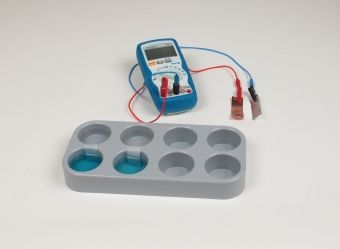Principle
A complete galvanic cell is to be set up in this experiment. The terms potential and potential difference can be introduced. In a complete "galvanic cell", two electrodes of different metals each dip in an aqueous solution of one of their own salts. In a copper/zinc cell, therefore, a copper electrode dips in a solution of copper sulphate, and a zinc electrode in a solution of zinc sulphate. The transport of current between the two solutions is made possible by connecting them with a conductive connection.
In the cell described here, and in other cells described later in this course, the key is a strip of filter paper which is wetted with potassium nitrate solution and placed across the two solutions, with one end dipping in one solution and the other end in the other solution. The system made up of a metal electrode and a solution of that metal is called a "half-cell". A complete galvanic cell so consists of two half-cells and the connecting key.
Learning objectives
- Principle of a galvanic cell
- Principle of the Daniell cell
Benefits
- Easy teaching and efficient learning by using interactive experimentation PHYWE-Software
- Experiment is part of a complete solution set with experiments for the topic Electrochemistry matched with international curriculum: all topics are covered




